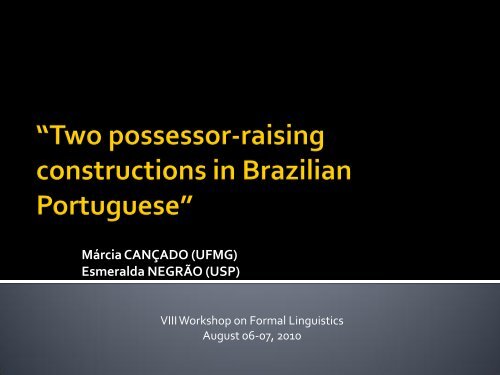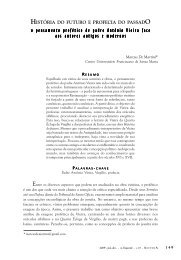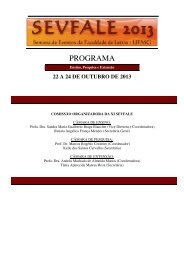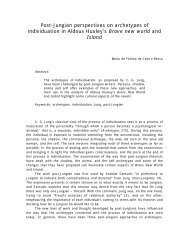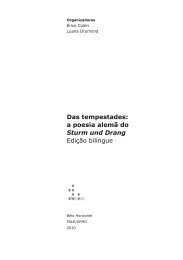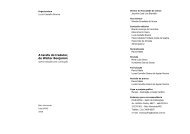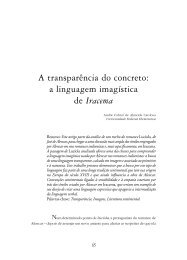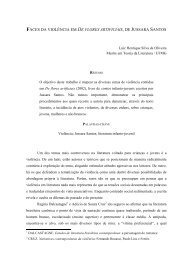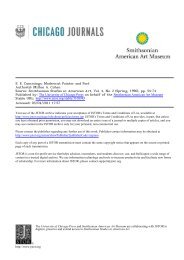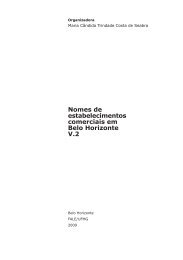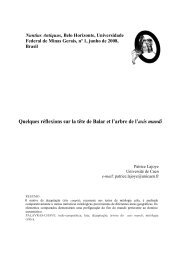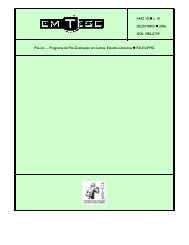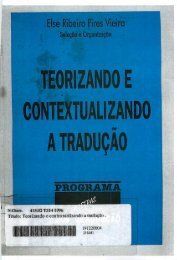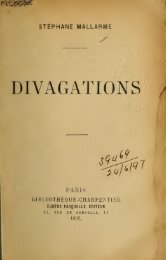workshop usp.pdf - UFMG
workshop usp.pdf - UFMG
workshop usp.pdf - UFMG
You also want an ePaper? Increase the reach of your titles
YUMPU automatically turns print PDFs into web optimized ePapers that Google loves.
Márcia CANÇADO (<strong>UFMG</strong>)<br />
Esmeralda NEGRÃO (USP)<br />
VIII Workshop on Formal Linguistics<br />
August 06-07, 2010
We analyze two types of possessor raising<br />
constructions in Brazilian Portuguese :<br />
(1) a. O cabelereiro cortou o cabelo do João.<br />
the hairdresser cut the hair of João<br />
‘The hairdresser cut João’s hair.’<br />
b. O João cortou o cabelo.<br />
João cut the hair<br />
‘João had his hair cut.’
(2) a. Alguém quebrou o braço do João.<br />
someone broke the arm of the John<br />
‘Someone broke John’s arm.’<br />
b. O João quebrou o braço.<br />
João broke the arm<br />
‘João broke his arm.’<br />
At first sight, these sentences seem to be<br />
identical, but they differ in semantic and<br />
syntactic aspects.
We claim that in both cases, verb alternations<br />
are instances of possessor raising. Based on<br />
semantic aspects and distributional syntactic<br />
properties which distinguish the sentences in<br />
(1) and (2), Cançado (2010) classifies verbs<br />
such as cortar ‘cut’ and quebrar ‘break’ in two<br />
different classes due to differences in their<br />
lexical properties.
1) to offer an account to the lexical properties<br />
observed in the two classes of verbs in terms of<br />
a syntactic treatment of argument structure,<br />
such as proposed by Hale and Keyser (2002);<br />
2) to show that the different lexical configurations<br />
associated with each verbal class entail two<br />
different possessive raising constructions;
3) to argue that a smuggling approach (Collins,<br />
2005) to the possessor raising associated with<br />
the class of verbs such as cortar ‘cut’<br />
accommodates in a better way the syntactic and<br />
semantic properties involved in this verb class.
Cançado (2010) shows in her paper that there<br />
are semantic and syntactic properties which<br />
distinguish sentences in (1) and (2), in a<br />
distributional way. These differences are due<br />
to lexical properties of the sentence verbs.
1.The semantic interpretation of the<br />
constructions:<br />
(3) a. João cortou o cabelo.<br />
b. João had someone cut his hair<br />
deliberately.<br />
(4) a. João quebrou o braço.<br />
b. *João had someone broke his arm<br />
deliberately.<br />
c. João had his arm broke accidentally.
2.The presence of the agent as an adjunct<br />
(5) O João cortou o cabelo com o cabeleireiro.<br />
João cut the hair with the hairdresser<br />
‘João had his hair cut by the hairdresser.’<br />
(6) *O João quebrou o braço com alguém.<br />
João broke the arm with someone
3. The modifiers<br />
(7)a. *O João cortou o cabelo com o cabelereiro<br />
acidentalmente.<br />
João cut the hair with the hairdresser<br />
accidentally<br />
b. O João cortou o cabelo com o cabelereiro<br />
intencionalmente.<br />
João cut the hair with the hairdresser<br />
intentionally
3. The modifiers<br />
(8) a.O João quebrou o braço acidentalmente.<br />
João broke the arm accidentally<br />
‘João broke his arm accidentally.’<br />
b.*O João quebrou o braço<br />
intencionalmente. (non-agentive reading)<br />
João broke the arm intentionally<br />
‘João broke his arm intentionally.’
4. Inanimate subjects<br />
(9) a. O João cortou o galho da árvore<br />
‘João had the tree’s branch cut.’<br />
b. *A árvore cortou o galho.<br />
the tree cut the branch<br />
(10) a. O João quebrou o galho da árvore<br />
‘João broke the tree’s branch.’<br />
b. A árvore quebrou o galho.<br />
the tree broke its branch
These facts lead Cançado (2010) to<br />
conclude that the subject of example in (1b)<br />
has some kind of agentivity, and it can be<br />
interpreted as if an indirect agent permits<br />
another agent to act in his place. This<br />
linguistic phenomenon allows both agents to<br />
be present in the sentence.
5. The syntactic distinctions: causative<br />
alternation<br />
(11) a. O cabelereiro cortou o cabelo do João.<br />
‘The hairdresser cut John’s hair.’<br />
b. *O cabelo do João cortou.<br />
‘*John’s hair cuts.’<br />
(12) a. Alguém quebrou o braço do João.<br />
‘Someone broke John’s arm.’<br />
b. O braço do João quebrou.<br />
‘John’s arm broke.’
Cançado (2010) calls the first type of<br />
possessor raising, example in (1b), “agentpossessor<br />
alternation”.<br />
The second type, example in (2b), “bodypossessor<br />
alternation”.<br />
We assume this terminology to make our<br />
description easier .
Agent-possessor examples:<br />
(13) a. O funcionário xerocou o artigo do João.<br />
‘The employee photocopied João's paper.’<br />
b. João xerocou o artigo.<br />
‘João had his paper photocopied.<br />
(14) a. O rapaz lavou o carro de Maria.<br />
‘The boy washed Maria's car.’<br />
b. Maria lavou o carro.<br />
‘Maria had her car washed.'
(15) a. O médico operou o nariz do João.<br />
‘The doctor operated on João's nose.’<br />
b. O João operou o nariz.<br />
‘João had his nose operated on.<br />
(16) a. O dentista extraiu o dente de João.<br />
‘The dentist extracted John’s tooth.’<br />
b. João extraiu o dente.<br />
João extract the tooth.<br />
‘João had his tooth extracted.
Some other agentive verbs that permit this<br />
alternation form are:<br />
(17) afiar ‘sharpen’, anestesiar ‘anesthetize’,<br />
limpar ‘clean’; consertar ‘fix’, decorar<br />
‘decorate (a house)’, demolir ‘demolish’,<br />
construir ‘build’, esterelizar ‘sterilize’,<br />
fotografar ‘photograph’, gravar ‘record’,<br />
pintar ‘paint’, radiografar ‘radiograph’, retirar<br />
‘remove’, remover ‘remove’...
The body-possessor examples:<br />
(18) a. Alguém quebrou o pescoço/ o braço/ a<br />
perna do João.<br />
‘Someone broke João's neck/arm/leg.’<br />
b. O João quebrou o pescoço/o braço/a<br />
perna.<br />
‘João broke his neck/arm/leg.’
(19) a. Um prego furou o pneu do carro.<br />
‘The nail punctured the car tire.’<br />
b. O carro furou o pneu (com um prego).<br />
‘The car had its tire punctured by a nail.’<br />
(20) a. A chuva estragou o ponteiro do relógio.<br />
the rain ruined the hand of the clock<br />
‘The rain ruined the clock hand.’<br />
b. O relógio estragou o ponteiro (com a chuva).<br />
‘The clock had its hand ruined by the rain.’
Other causative verbs that allow this<br />
alternation form are:<br />
(21) apagar ‘put out’, apodrecer ‘rot’, arranhar<br />
‘scratch’, arruinar ‘ruin’, arrebentar ‘break’,<br />
cortar ‘hurt’, contundir ‘bruise’, desbotar<br />
‘discolor’, destruir ‘destroy’, machucar ‘hurt’,<br />
queimar ‘burn’, rasgar ‘tear’, torcer ‘ twist’,<br />
trincar ‘crack’ …
At this point, we should conclude that<br />
agentive verbs accept the agent–possessor<br />
alternation and causative verb accept the<br />
body-possessor alternation. Nonetheless,<br />
some agentive verbs do not accept the<br />
alternation and also some causative verbs do<br />
not accept the body-possessor alternation.
Examples of agentive verbs that do not accept<br />
the agent-possessor alternation:<br />
(22) a. João leu/analisou o artigo do professor.<br />
‘João read/analyzed the teacher´s paper.’<br />
b. *O professor analisou o artigo (com o João).<br />
(in a reading in which João did it in the<br />
professor’s place).<br />
the teacher read/analyze the paper (with João)
(23) a. Maria comeu o peito da galinha.<br />
‘Maria ate the chicken’s breast.’<br />
b. *A galinha comeu o peito (com a Maria).<br />
the chicken ate the breast (with Maria)<br />
(24)a.O João escreveu o discurso do presidente<br />
‘João wrote the speech of the president.’<br />
b. *O presidente escreveu o discurso (com o<br />
João).(in a reading in which João did it in the<br />
president’s place).<br />
the president wrote the speech (with João)
Examples of causative verbs that do not allow<br />
the body-possessor alternation:<br />
(25)a. A tempestade derrubou a raiz da árvore.<br />
‘The storm uprooted the tree root.’<br />
b. *A árvore derrubou a raiz.<br />
the tree uprooted the root<br />
(26) a. A ventania carregou a porta da casa.<br />
‘The wind carried the door house.’<br />
b. *A casa carregou a porta.<br />
the house carried the door
(27) a. A beleza do rapaz conquistou o coração de<br />
Maria.<br />
‘The boy’s good looks won Maria’s heart.’<br />
b. *Maria conquistou o coração.<br />
Maria won the heart<br />
(28) a. O menino arrancou a folha do caderno.<br />
‘The boy tore the note pad sheet.’<br />
b. *O caderno arrancou a folha.<br />
the note pad tore the sheet
Therefore, before we go further on the<br />
syntactic analysis, it is worth to specify on<br />
which conditions these verb classes allow the<br />
possessor raising to the subject position of<br />
these specific sentences.
The semantic nature of the verbs<br />
1.) Both verb classes must be causative<br />
constructions, that is to say, they must be an<br />
event that denotes two sub-events.<br />
2.) The agent-possessor type verbs must be<br />
“result verbs” (Rappaport and Levin, 2010).
The semantic nature of the verbs<br />
3.) The body-possessor type of verbs must<br />
denote a change of state. (Parsons, 1990;<br />
Cançado and Godoy, 2010)<br />
4.) The agent-possessor sentence must have<br />
an agent in the external argument position.
The predicate semantic structure<br />
cortar ‘cut’:<br />
[AGENT] CAUSE [Y BE ]<br />
quebrar ‘break’:<br />
[EVENT] CAUSE [Y BECOME ]
However, even if some agentive verbs like<br />
those above do not undergo “possessor<br />
raising”:<br />
(29) a. O João rasgou o caderno do Paulo.<br />
‘João teared Paulo’s notebook.’<br />
b. *O Paulo rasgou o caderno (com o João).<br />
Paulo teared the notebook (with João)
But, even if we reach the semantic conditions,<br />
the alternation is only allowed if we can infer<br />
from the VP a kind of action that you usually ask<br />
someone else, an expert, to do for you;<br />
otherwise, the alternation fails.
Finally, both alternating basic sentences must<br />
have an argument in object position that<br />
denotes a possession relation. But<br />
additionally, the possessor relation of the<br />
body-possessor alternation must be<br />
exclusively a whole-part relation.
Argument Structure:<br />
syntactic configurations projected by a lexical<br />
item<br />
is determined by properties of lexical itens, in<br />
particular the syntactic configurations in which<br />
they must appear<br />
There are just two syntactic relations,<br />
complement and specifier
Based on the empirical facts, two different argument<br />
structures are proposed for quebrar and cortar:<br />
Hale & Keyser propose that verbs of the break class<br />
consist of two structural elements: a root (R) and a verbal<br />
host (V). The verbal component takes a complement,<br />
realized as the root. The root contains the semantic and<br />
the phonological features. The root requires a specifier.<br />
This configuration accounts for the fact that verbs of the<br />
quebrar class participate in the transitive alternation.<br />
We will extend this proposal to the quebrar verb class in<br />
BP.
V<br />
3<br />
DP V<br />
6 3<br />
o braço de João V R<br />
quebrar
Based on the empirical facts presented, two<br />
different argument structures are proposed for<br />
quebrar and cortar:<br />
Hale &Keyser propose that verbs of material<br />
separation like cut are based on nouns. Their<br />
structure is headed by a preposition. They take both<br />
a complement and a specifier.<br />
We will extend this proposal to the cortar class of<br />
BP.
V<br />
3<br />
V P<br />
3<br />
DP P<br />
6 3<br />
o cabelo de João P N<br />
corte
Possessive Dative Construction properties<br />
possessive dative must be interpreted as<br />
possessor/creator, not object/theme<br />
possession (or creation) interpretation is obligatory (agent<br />
subject of a process nominal cannot be associated with<br />
PD)<br />
the possessed DP cannot be an external argument<br />
PD must c-command the possessed DP (or its trace)<br />
possessive interpretation is constrained by locality<br />
(Landau, 1999, p.9)
Landau (1999): a case driven movement analysis for<br />
Possessive Dative Constructions (PDC) in Hebrew<br />
and Romance languages<br />
the possessor is generated in a caseless Spec<br />
position within the possessee<br />
it is generated with dative case features<br />
it then raises to check its case features with V (p.9)
Lunguinho (2006) provides data with quantifier floating in<br />
support to the DP structure in possessor raising<br />
constructions:<br />
(30)a. Todos os carros furaram o pneu dianteiro<br />
all the cars punctured the front tire<br />
[ TP Todos os carros furaram [ DP todos os carros [ D’ o pneu<br />
dianteiro]<br />
b. Os carros furaram todos o pneu dianteiro<br />
[ TP Os carros furaram [ DP todos os carros [ D’ o pneu<br />
dianteiro]<br />
c.*Os carros furaram o pneu dianteiro todos<br />
[ TP Os carros furaram [ DP o pneu dianteiro todos os carros]
Possessor Raising with quebrar
Possessor Raising with cortar: a smuggling<br />
approach<br />
Collins (2005) proposes a smuggling approach to<br />
passives:<br />
the external argument is merged into the<br />
structure in the same way, both in active and<br />
passive sentences<br />
in passives, a participle must be licensed by<br />
moving to the specifier position of a functional<br />
category VoiceP<br />
the preposition by is the head of the functional<br />
projection VoiceP
The definition of smuggling (Collins, 2005):<br />
“Suppose a constituent YP contains XP. Furthermore,<br />
suppose that XP is inaccessible to Z because of the<br />
presence of W (a barrier, phase boundary, or an intervener<br />
for the Minimal Link Condition and/or Relativized<br />
Minimality), which blocks a syntactic relation between Z<br />
and XP (e.g., movement, Case checking, agreement,<br />
binding). If YP moves to a position c-commanding W, we<br />
say thatYP smuggles XP past W.” (p. 97)
Empirical evidence showed that we are dealing with<br />
two different phenomena.<br />
This difference was captured in terms of distinct<br />
lexical syntactic structure of two different verb<br />
classes.<br />
We showed that BP has two different possessor<br />
raising constructions: the first, with verbs such as<br />
quebrar, treated in terms of head movement, and<br />
the second, with verbs such as cortar, treated in a<br />
smuggling approach.
Camacho, R. (2003) Em defesa da categoria de voz média no português. DELTA, 19 (1), 91-122.<br />
Cançado, M. (2010) Verbal Alternations in Brazilian Portuguese: a Lexical Semantic Approach.<br />
Studies in Hispanic and Lusophone Linguistics, 3 (1):p. 77-111.<br />
Cançado, M. & Godoy, L. (2010) The L-Syntax and L-Semantics of Verb Classes in Brazilian<br />
Portuguese. Manuscript. (www.letras.ufmg.br/profs/marciacancado)<br />
Collins, C. (2005) A Smuggling Approach to the Passive in English. Syntax. 8 (2): 81-120.<br />
Everett, D. (1986) Possessor Raising and Ergative Structures in Brazilian Portuguese.<br />
Manuscript.Universidade Estadual de Campinas at Brazil.<br />
Hale, K. & Keyser, S.J. (2002). Prolegomenon to a Theory of Argument Structure. Cambridge:<br />
MIT Press.<br />
Floripi, S. (2004). Argumentos Nulos dentro de DPs em Português<br />
Brasileiro. Master’s Thesis, Universidade Estadual de Campinas.<br />
Floripi, S. & Nunes, J. (2009). Movement and resumption in null possessor constructions in<br />
Brazilian Portuguese. In Jairo Nunes (ed.) Minimalist essays on Brazilian Portuguese<br />
Syntax. Amsterdan: John Benjamins Publishing Company, pp. 51-68.
Levin, B. (1993) English verb classes and alternations: a preliminary investigation.<br />
Chicago: The University of Chicago Press.<br />
Landau, I. (1999) Possessor Raising and the structure of VP. Lingua, 107: 1-37.<br />
Lunguinho, M.V. (2006) Partição de constituintes no PB: características sintáticas e<br />
semânticas. In: Denize E.G. da Silva (Org.) Língua, Gramática e Discurso. Goiânia:<br />
Cânone, pp.133-147.<br />
Parsons, T. 1990. Events in the Semantics of English: a study in subatomics semantics.<br />
Currents Studies in Linguistic Series 19, MIT Press, Cambridge, Massachussets.<br />
Perini, M. (2008) Estudos de Gramática Descritiva: as valências verbais. São Paulo:<br />
Parábola.<br />
Pontes, E. (1986) Sujeito: da sintaxe ao discurso. São Paulo: Ática.<br />
Negrão, E.V. (1997) Asymmetries in the distribution of overt and empty categories in<br />
Brazilian Portuguese. In: J.R. Black & V. Motapanyane. Clitics, Pronouns and<br />
Movement. Amsterdan: John Benjamins Publishing Company, pp. 217-238.<br />
Rodrigues, C. (to appear) Possessor Raising through Thematic Positions. Manuscript.<br />
University of Brasilia.
Thank you!


